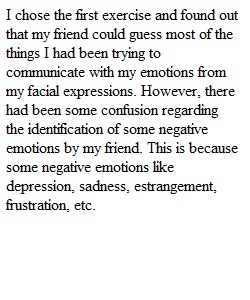


Q Chapter 4 discussions the wide variety of nonverbal communication skills - from facial expressions and eye contact to gestures and vocal cues. It's amazing how many "nonverbals" influence our communication with others! In fact, common statistics state that 80% of all communication has nothing to do with the words we say, but more with how we say them, and the nonverbal signals we send. Below are 3 exercises we would normally do in class to bring awareness to our personal nonverbal communication styles. Review the exercises below, and PICK ONE to do on your own. Once you're done, post your thoughts in the discussion post. What did you learn about yourself? What did you learn about nonverbal communication? How does this influence the way you communicate with others? Your original post should be 150 words minimum. Please reply to two other students with a substantive reply, 50 words minimum. Exercises: 1.) Facial Expressions: Find a friend and demonstrate different emotions using facial expressions only. Can your friend guess what you are trying to communicate? Emotions: sadness, frustration, happiness, love, fear, anger, excitement, boredom. 2.) Eye Contact and Focus: Find a friend and ask them to listen while you share a story or information with them (2 or 3 minutes). Ask your friend to demonstrate NO INTEREST while you talk - no eye contact, look away, act disinterested. How does that make you feel? Now, tell the story again and this time your friend should demonstrate interest. What does your friend do differently? How does it make you feel? 3.) Spatial Relationships: Are you a close talker? How close is too close? Get with a friend and stand at "public distance" (12 feet apart). Start talking to each other - how does it feel to be so far apart? Now, get closer to "social and work distance" (4-12 feet apart), then "personal distance" (18 inches - 4 feet apart). At what distance are you most comfortable? What about "intimate distance" (0-18 inches)? Is that too close?
View Related Questions